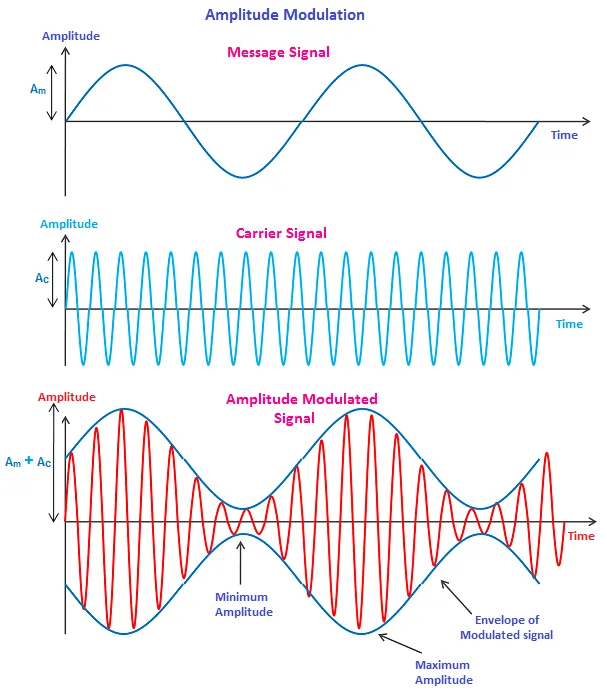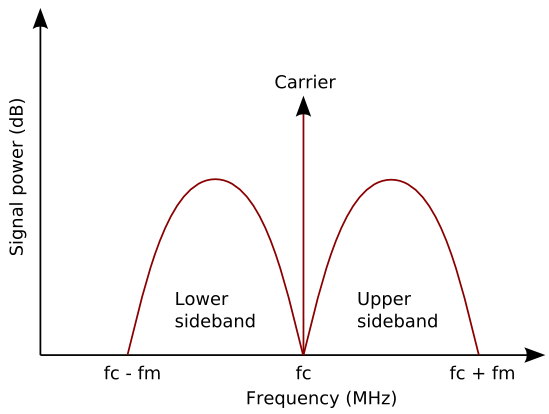Table of Contents
Confession time: Modulation modes is one of those things that took me a long time to grasp. I couldn’t wrap my head around it and because I struggled to understand modulation modes…I got myself wrapped around the axle on wavelengths and frequencies. I definitely overthought it but here we are.
First, a clarification. Modulating modes vs. Operating modes. Modulating modes are the way in which a radio signal is altered (“modulated”) to contain information. Operating modes is more of a slang term for what a particular radio operator is doing – voice, cw, digital, etc.
Generally here I want to get across the concept of what a modulation mode is and how it impacts bandwidth usage. I’m not even going to try to cover every modulation mode in detail because I don’t have a comprehensive understanding of every mode under the sun.
So, with that out of the way. Let’s talk modulation modes and bandwidth generally and then we’ll move on to CW, AM, SSB and FM.
Signal modulation is taking a radio signal and encoding information into that signal. It can be done by changing the amplitude of a signal, the frequency of a signal or the phase of a signal…or in the case of CW simply turning the signal on and off.
Understand that when a signal is modulated, it’s not just a single frequency that’s being modulated but instead an entire band of frequencies. The size of the band being modulated changes depending on the particular type of modulation being performed. Remember that a band of frequencies is a contiguous set of frequencies. The size of the band needed for a particular modulation mode is known as the modulation mode’s bandwidth.
Now, if you’re like me. You’re wondering why we only see a single frequency on our radio if we’re actually operating on a band. Well, mostly it’s shorthand to make life easier. The signal you tune into is known as a carrier frequency. That’s simply the frequency you tune to to begin operating in the mode. The bandwidth of the mode will describe how much of the band above and below the carrier frequency is consumed.
Bandwidth of common modulation modes
Every modulation mode requires a different amount of bandwidth. Here are the bandwidths of a few of the most common modulation modes.
| Continuous Wave (CW aka Keying aka Morse Code) | 150 Hz |
| Single Side Band (SSB, USB, LSB) | 3000 Hz |
| Amplitude Modulation (AM) | 6000 Hz |
| Frequency Modulation (FM) | 5000 – 15000 Hz |
| PSK31 (one of many digital modes) | 31000 Hz |
Signal power as it relates to modulation mode
One pattern that you’re going to see is that the smaller the amount of bandwidth an operating mode requires, the more powerful the signal can be without pumping in additional power at the point of transmission. You can think of this as having a set amount of power to spread equally across a mode’s entire bandwidth.
More bandwidth means you must allocate less power to each individual frequency inside the band because you need to give each frequency power. If you have the same amount of power but a smaller bandwidth then you can allocate more power to each frequency in the band.
As an analogy: If I have ten apples and ten kids, each kid gets one apple. If I have ten apples and two kids then each kid gets five apples.
Continuous Wave (CW) modulation
Continuous wave modulation (CW) is probably the most famous mode of radio communication. It’s when you use a key to simply turn a radio signal on and off to encode information using morse code. Because you’re simply turning the signal on and off this modulation mode uses very little bandwidth, only 150 Hz.
Amplitude Modulation (AM)
Amplitude Modulation (AM) is the process of taking a consistent carrier signal and mixing it with a modulated audio signal to change the amplitude, but not the frequency or phase, of the signal.
In the case of amplitude modulation you tune into the carrier signal and then listen to the sidebands, In amplitude modulation each of the sidebands is approximately 3,000 Hz wide for a total bandwidth of 6,000 Hz. The upper and lower sidebands are identical to each other. This creates a rich sound and a robust signal at the expense of additional bandwidth. AM modulation is also easy to perform at a technical level.

Single Side Band (SSB) modulation

Single side band (SSB) modulation takes the AM modulation and strips out one of the side bands and the carrier wave. This can be done because both sidebands in an AM signal are identical so no information is lost. By filtering out one of the sidebands and the carrier at the point of transmission, the bandwidth of SSB is half of an AM transmission – 3,000 Hz instead of 6,000 Hz. [Aside, most stations run a receive filter than further reduces the size to 2,500 Hz but that’s out of scope here]
SSB has a number of advantages over AM. First, it creates less “band pollution” have consuming less bandwidth. Second, because the needed bandwidth is smaller you can create a stronger signal without increasing your power output.
So if SSB is suppressing a sideband, how do you identify which sideband is suppressed? That’s where Upper Sideband and Lower Sideband come into play. If you’re transmitting on Upper Sideband (USB) then the Lower Sideband is Suppressed. If you’re transmitting on Lower Sideband (LSB) then the Upper Sideband is suppressed.
A carrier signal is required to demodulate (read) the signal so how is that received? It usually isn’t, instead it’s inserted by the receiving radio using a beat frequency oscillator. If the carrier inserted is too far off the original the pitch of the audio will change until it becomes unintelligible.
There are a couple of SSB variants out there in the wild that either leave the carrier signal in place (SSB Full Carrier) or leave a reduced carrier signal in place (SSB Reduced Carrier). Another uncommon variation of SSB is Independent Sideband (ISB) where each sideband carries different information.
There are no official rules regarding where LSB and USB should be used but by convention, all bands above 30m (>10 MHz) including VHF & UHF use Upper Sideband. Bands lower than 30m use Lower Sideband.
Frequency Modulation (FM)
So far we’ve looked AM and a smaller bandwidth variant of AM called SSB. Both of those modulate the signal by changing it’s amplitude. Now let’s look at something completely different. Frequency Modulation (FM), in contrast to AM, has a consistent & unchanging amplitude by varies the frequency within the signal.
FM typically uses much more bandwidth than AM and always uses more bandwidth than SSB. Because of this the FCC limits Frequency modulation to higher bands only. Specifically, you’re only allowed to use FM on 10m and higher (10m, 6m, 2m, 1.25m and 70cm) where more bandwidth is available due to smaller wavelengths.
FM can have a richer sound than AM and the quality of the signal is less impacted by environmental conditions but FM signals can quickly become unusable when a signal is weak making it less useful in long range or low power communications.
Wrapping up: Preferred modes on bands
- UHF and VHF: AM and FM are common on the UHF and VHF bands. SSB is possible but it’s less used.
- HF: There’s less bandwidth available on HF bands due to wave size so conservation of band is more of a concern. On HF SSB and CW are more common. In fact, FM is even prohibited on some HF bands.